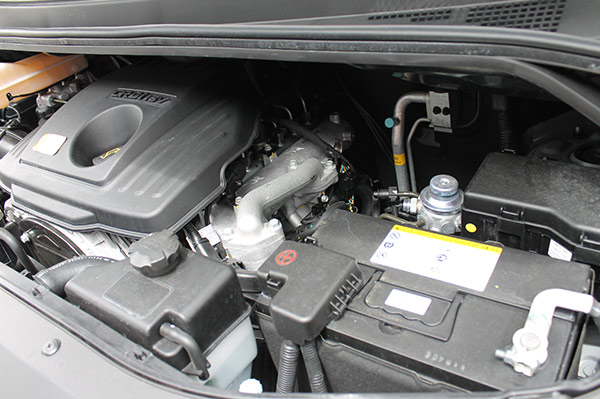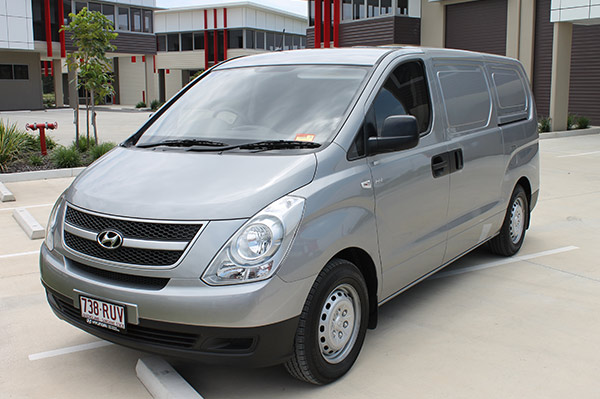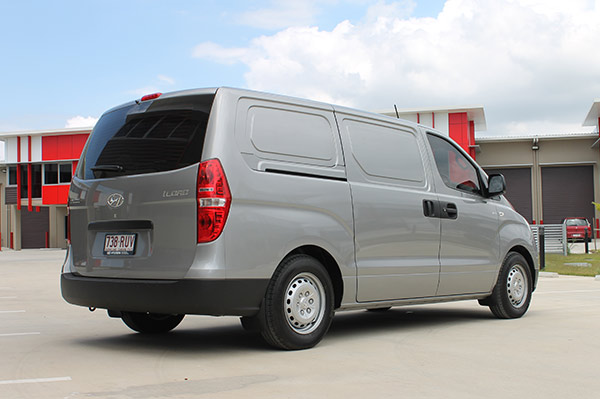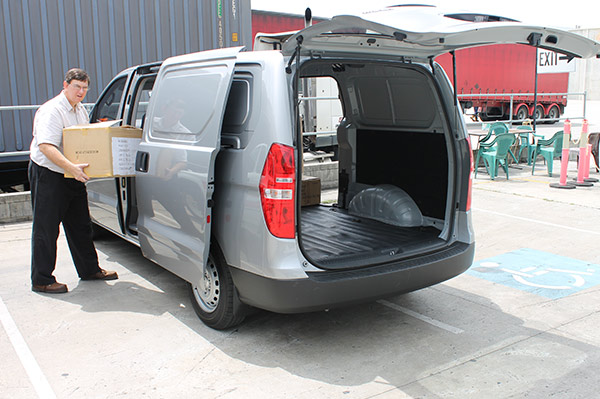Hyundai’s iLoad van is making serious in-roads into the ‘final mile’ pick-up and delivery market. Gary Worrall took one for a drive to see just how good they are.
Hyundai’s solution to the growing demand for light-duty deliveries is the long wheelbase iLoad van, the cargo version of its iMax people mover, available in either three- or five-seat configuration.
The five-seater is an interesting option, allowing a work team to travel in a single vehicle while still carrying tools for pallet repacks or other urgent tasks.
The focus of this test though is the three-seat delivery van, rated for a 1-tonne payload with the capability to take a decent cubic load if required.
Thankfully the day of the slab-fronted van is long gone. Instead the design is semi-bonneted, providing a degree of protection in a frontal impact as well as creating an aerodynamic nose to improve fuel economy.
Hyundai has a long tradition of using free-form reflectors in the headlights, allowing designers to create a unique look, with deep, highly effective, headlamps that follow the lines of the front guard almost to the A-pillar.
The front bar is deep, stretching down from the bottom of the headlights; again the design is dual purpose, providing a ‘chin’ for the van’s face, as well as being a pedestrian-friendly deformable structure in a low-speed crash.
To meet the demands of a large capacity cargo area, the iLoad has tall straight sides. Unfortunately, this creates one problem, the body is susceptible to cross winds. Even with a heavy load on board, the driver will notice plenty of straightline body roll.
The ride height is made even taller by Hyundai’s choice of tyres and rims, in this case a 16-inch rim wearing 70 Series tyres. Not only do they make the van sit up straight but provide a layer of cushioning from road shock.
This is a clever move by the designers. The tyres contribute to the load carrying capability of the van while allowing the suspension to be set stiffer than if it was working independently, which in turn improves the road holding and handling.
There is minimal wind noise around the A-pillars and oversize door mirrors, proof the design team is serious about creating a pleasant work environment.
The front doors are large with a wide opening, accessed via two tall steps, necessary thanks to the high ride height which offers plenty of ground clearance but also contributes a high centre of gravity, exacerbating body roll.
While most operators will choose white, one advantage to sharing its structure with the passenger range is a wide selection of body colours, helping the iLoad stand out from the pack.
Externally, the panel fit is excellent; the gaps are minimal and even across the body, another factor contributing to the comfortable ride as there are no draughts or extraneous noises entering the cockpit.
Engine
Powering the iLoad is a 2.5-litre turbocharged diesel with common rail fuel injection. The over-square engine punches out 392Nm of torque and 125kW of power, perfect for its role as a delivery van and a big help in overcoming the inertia of the torque converter from a standing start.
Transmission
The engine is backed by a computer controlled 5-speed automatic transmission, while active safety includes ABS and EBD along with traction and stability control.

Cab and Controls
Entering the driver’s seat is almost the reverse of Neil Armstrong’s famous ‘one small step for a man’ speech when he first walked on the moon in 1969.
Instead this is a giant leap for a man, with an access step recessed into the doorway around the front wheel that was greatly appreciated by the vertically challenged members of the road test crew.
For those over 180cm, the step is handy but not necessary, although it does mean you sometimes find yourself sliding down from the seat on exit if you choose to go it alone.
The seats are tall and padded thickly for comfort, with a wide base that offers plenty of under leg support, especially welcome on longer drives.
The seat backs are also broad, allowing the driver to settle in during inter-city cruises, while the raised seat position makes spotting those elusive ‘Loading Zone’ signs a lot easier.
From a comfort and convenience perspective, the iLoad is well equipped with drink holders, there are two cup holders mounted front and centre in the dash, as well as ‘bottle bulges’ in the front door pockets.
The steering wheel can be adjusted for height and reach, allowing drivers to make the most of the seating position, and is also well padded for comfort so that the driver does not develop a death grip while steering.
Despite looking like it was designed for a much larger vehicle, the wheel does an excellent job of not obscuring the view of the instrument binnacle. Instead, the driver has a clear look at the speedo and tacho, with smaller dials taking care of temperature and fuel levels.
All other major functions are handled via simple warning lights, so no light means no problem.
Hyundai has been quick to seize in-cab electronics advances, meaning the iLoad is offered with a Bluetooth-compatible AM/FM/CD/MP3 stereo with iPod integration; a long way of saying you can plug almost any device into the entertainment system.
For iPhone and iPod users in particular, this is a great advantage, as Hyundai has hard-wired a connector to plug straight into the device allowing full access via the stereo system, while the Bluetooth system offers crystal clear voice reproduction.
Courtesy of the semi-bonneted design, the dash is deep under the sloped windscreen; the bad news is this means air-conditioning is no longer an option as it creates a massive glasshouse for the sun’s rays to bake the occupants without the climate system running.
The good news is the deep dash presents another layer of occupant protection in an accident, while the driver and outboard passenger have the added protection of front SRS airbags, while the iLoad is certified to a 4-star level by the Australian New Car Assessment Program (ANCAP), the best score held by any commercial vehicle.
As if to show no stone has been left unturned to create the perfect courier mobile office, the iLoad can even be ordered with an optional fridge, perfect for keeping food and drink at the ideal temperature regardless of the weather outside.
Just like the exterior, the interior is well finished. Hyundai uses quality materials including plastics and vinyls for the dash, while the seats are covered in a hard wearing, but comfortable, cloth which also offers good ‘breathability’ to help keep occupants cool in hot weather.
For the fastidious operator there are also easy-clean rubber floor mats available, while the van can also be specified with either a rubber floor mat, a good option for carton carriers, or a timber floor, which would be ideal for pallet operations in conjunction with the barn doors where forklifts can slide loads across the floor without tearing up the floor covering.

Performance
Even with a heavy load in the back, the iLoad is a respectable performer, holding its own in traffic all the way up to highway speed, with plenty in reserve for overtaking if the need arises.
The engine does get a little raucous when pushed hard, however it avoids becoming unpleasant, merely vocal about advertising the fact it is working.
Similarly, the gearshifts are smooth without being silky; however this is hardly a surprise or a setback for a transmission that can lug a couple of tonnes around town in stop-start traffic.
The iLoad uses a large diameter steering wheel that would feel right at home in the company’s truck range. The positive point is it reduces the effort needed to coax the van into changing directions; it just isn’t as ‘sexy’ as the small tiller found in some vehicles.
Like most commercials, there is some vagueness around the ‘dead ahead’ position, but Hyundai’s engineers have worked to eliminate the worst of it, now it is just a case of polishing off the rough edges.
The brakes are effective without being overly aggressive. The iLoad uses an all-wheel-disc combination with ABS and EBD braking, as well as ESP and traction control to help keep the cargo right side up.
For this, the brakes do an excellent job. Although the pedal is a tad soft for some, this can be adjusted on request, but the bottom line is a well driven commercial vehicle relies as much on the driver’s situational awareness of merging traffic and other hazards as it does on the brake pedal.
The soft pedal offers a range of movement to gradually wash off speed, before reaching the emergency stage, which is a good thing as that is usually when unsecured cargo become projectiles.
Although competent, the brakes only provide a vague description of what is happening at the wheels, and while the computer is more than capable of dealing with emergency systems, drivers prefer a higher level of feel to help modulate their driving.
Hyundai’s use of high profile tyres not only offers a decent load-bearing capacity but the first level of shock absorption, so that the suspension can be set stiffer to deal with the weight of the cargo as well as to improve ride and handling.
The result is a van that offers decent grip levels when empty, at a time when most vans skip across the road like a pebble on water, while still smoothing out the bumps and corrugations common on Australian roads.
The cargo space is big. Hyundai has installed a flat floor in the iLoad, accessed by twin sliding doors down the sides and either a tailgate or barn door at the rear.
For parcel- and carton-sized loads, the tailgate is a good option, providing a single door tall enough for even 180cm and over people to access without crouching, as well as making it easier for the remote central locking to secure the van while the driver is away.
With a tall roof as standard, the iLoad offers a significant cubic capacity, so that loads such as bubble wrap, which take up a lot of space but weigh little, can be accommodated easily.
There are also pre-mounted tie-down hooks throughout the cargo bay, making it easy for the driver to lock the cargo quickly into place to prevent load shift while driving.
For operators carting denser loads that need mechanical assistance for loading and unloading, the only sensible choice is the barn door option, with two swing-out doors at the rear of the body, while retaining the sliders for side access.
For our test the iLoad was carrying a mixed skid of alcohol, providing a heavy weight on the rear.
Thanks to the efforts of a talented forklift operator, we did eventually manage to safely load the van. However the reality is that for repeated loading and unloading the barn doors are the only viable alternative.
The good news is the wheel arches are boxed in so that a 1,200mm pallet will fit comfortably between them, although a traditional Chep-type pallet will have to go on a traytop.

Verdict
The iLoad is a comfortable alternative to higher priced European vans with similar safety levels. However, the absence of cruise control in a market where even 5km/h over causes moral panic is hard to fathom.
Not only does it leave the driver open to the odd speeding event, it means constantly looking away from the road to confirm all is well with the speedo.
If Hyundai could just fix this, and certainly the automatic version should be an easy fix thanks to the computers talking to each other already for traction and stability control, the iLoad could easily take the mantle of best all-round delivery van.
Specifications
Make/Model: Hyundai iLoad
Configuration: 3 seat cargo van
GVM/GCM: 3,160kg/4,660kg
Length: 5,125mm (overall)/ 2,375mm (cargo)
Engine: 2.5-litre four cylinder diesel engine with Common Rail Direct injection (CRDi) intercooled with Variable Geometry Turbo (VGT)
Power/Torque: 125kW/392Nm
Transmission: 5-speed automatic, computer controlled
Brakes: 4-wheel discs, with ABS and EBD



